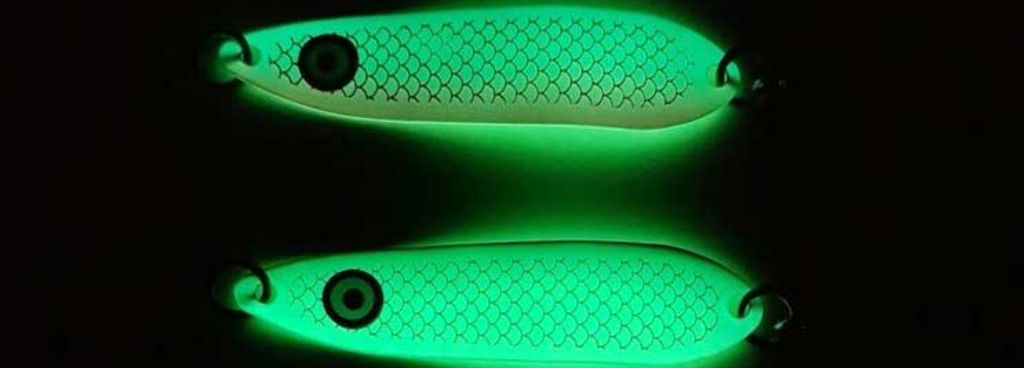Stories Worth Reeling In...
Last Updated on September 19, 2023
Do Fish Like Glow In The Dark Lures? It’s a question that has divided anglers for years. Some swear by their effectiveness, while others claim they’re just a gimmick. Glow-in-the-dark lures are nothing new, and I’ve met anglers who swear they hooked huge fish with them, as well as those who claim it’s a gimmick.
Hardcore anglers are always looking for a competitive advantage that will allow them to catch more and bigger fish. So I began to wonder if glow-in-the-dark lures caught more fish.
In this article, we’ll delve deeper into the science behind glow-in-the-dark lures, examine the arguments for and against their effectiveness, and provide tips on when and how to use them for maximum results.
Table of Contents
It is still unknown whether fish are drawn to glow-in-the-dark lures based on research and experiments. Others have found no appreciable difference in catch rates between glowing and non-glowing lures, despite some studies suggesting that some fish species may be drawn to the glowing light. Additionally, a fish’s response to a glowing lure can depend on a variety of variables, including the water’s characteristics, its feeding habits, and its species preferences.
A trendy option for anglers is glow-in-the-dark lures. Have you ever thought about how they operate, though? The lure’s unique ability to capture and hold light energy before releasing it as a glowing effect in low light is the key to its effectiveness.

Glow-in-the-dark lures are made possible by a process known as photoluminescence, which is a process. Materials like phosphors, which absorb light and store energy, are in the lure. Fish may be drawn in by the glowing appearance produced when the energy stored is released as light in low light or total darkness.
At night is the most obvious time to use glow-in-the-dark lures. More and more anglers are beginning to prefer night fishing, and it is reasonable to experiment with glow bait. It may take some trial and error to figure out what works best in your local waters.
Glow-in-the-dark lures are helpful for more than just night fishing. During the day, they can even work in deeper water. Jigging for Kokanee is an excellent opportunity to experiment with glow-in-the-dark lures. These fish swim in depths of 50 to 100 feet.
When the sun shines, and everything appears to be bright on the surface, it is easy to believe that its rays reach the bottom. However, light is drastically reduced in 10-15 feet of water.
Specific light wavelengths do not travel very far through the water. Beyond 15 feet, the red and orange colors on a lure fade to grey. It gets even darker when there are cloudy skies, wind chops, or poor water clarity.
UV rays penetrate the water deeper than visible light during the day, making a glow-in-the-dark lure shine and attracting predator fish. Holding a small flashlight on the lure for a few seconds at dawn or dusk will cause it to glow for several minutes.
You need to find a way to hook a glow stick and expect to catch fish. A glow-in-the-dark lure should incorporate subtle glowing details that add contrast and appear natural. Just enough glow is required to attract the attention of a fish. They’ll avoid it if it looks like nothing they’ve ever seen before.
Beyond the looks of the lure, use them for the suitable species in the proper conditions. Saltwater fish frequently consume bioluminescent prey. Glow bait is well known to catch salmon, squid, halibut, and rockfish.
The main question is whether they prefer glowing lures to non-glowing lures. Because most evidence lacks scientific proof, you may need to see for yourself and consult with other experienced anglers.
Walleye anglers get into heated debates about the use of glowing lures. Those who enjoy night fishing claim that their best catches have come from using glow-in-the-dark baits.
During the day, some anglers like to add glow beads to their trolling setup to entice deep water bites from wary feeders.
What draws a fish to your lure? Hunger and curiosity are frequently the most important factors, but in order to pique that hunger and curiosity, your lure must stand out from the surrounding water. Make your lure stand out by painting it with a glow-in-the-dark finish. This will make your lure stand out at night and can even improve visibility during the day, especially in deep or murky water. You’ve almost caught the fish once you’ve captured its attention.
Different lures are more effective for different types of fish. Use glowing lures if you want to attract predator fish like bass or salmon. Many predator fish have optimized their vision for color selection in order to better detect their prey. When the prey you want them to notice is your lure, you can take advantage of that color selection by using glowing colors to turn those predators into your prey.
While electronic lures that light up are prohibited in many areas, lures that glow due to the effects of paint or similar products are permitted. You can either buy ready-made lures and paint them with your glowing product or make them from scratch. Many people find it easiest to make soft plastic lures by building a lure mold, but others prefer to carve their own lures out of wood. Depending on the type of fish you want to catch, either method will work.

According to my research, there is no evidence that glow-in-the-dark lures are illegal for fishing. Some states prohibit the use of electronic lures with built-in lights, but not lures with glowing paint.
A successful fishing method may be made illegal in order to give fish a better chance and make fishing more sporting. Glow-in-the-dark lures are certainly useful in some situations, but they are far from a panacea.
Before you spend a fortune on a tackle box full of glowing lures, double-check your local fishing regulations to ensure they are legal to use where you live. To learn about your state’s fishing regulations, go to our Fish and Wildlife page.
In conclusion, glow-in-the-dark lures can be successful in some fishing situations, especially in low-light or deep-water circumstances. Personally, I’m still undecided about the benefits of glow-in-the-dark lures. On the one hand, it makes sense that fish are drawn to things that stand out and appear to be easy pickings.
Do fish enjoy glistening lures? The fish species and fishing conditions will determine the answer, according to the question. While some fish may be more sensitive to the glowing effect due to their innate attraction to light, others may not be at all impacted.
Understanding the conditions that glow-in-the-dark lures can be effective in is key, as is experimenting with various methods to determine which one suits you the best.